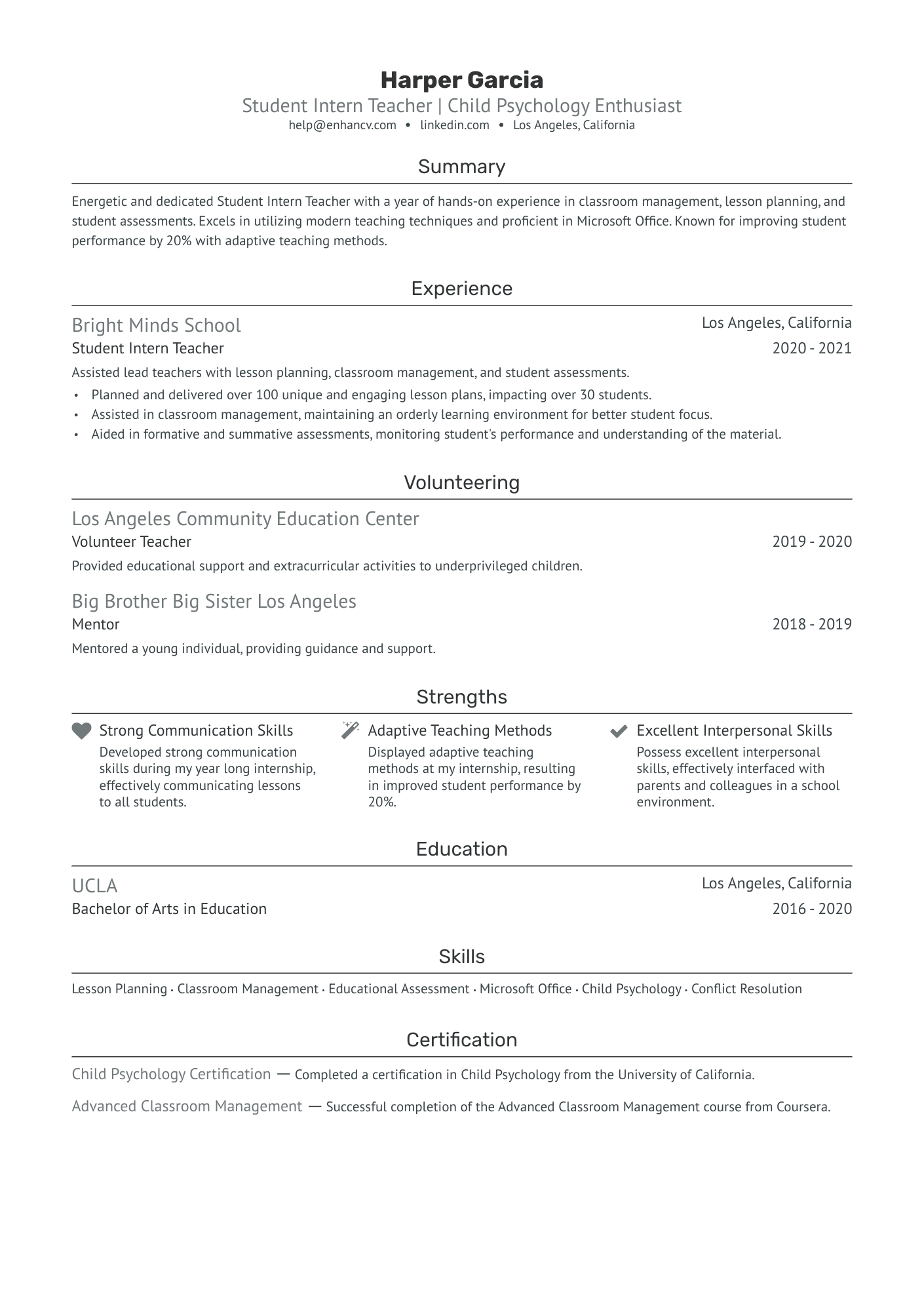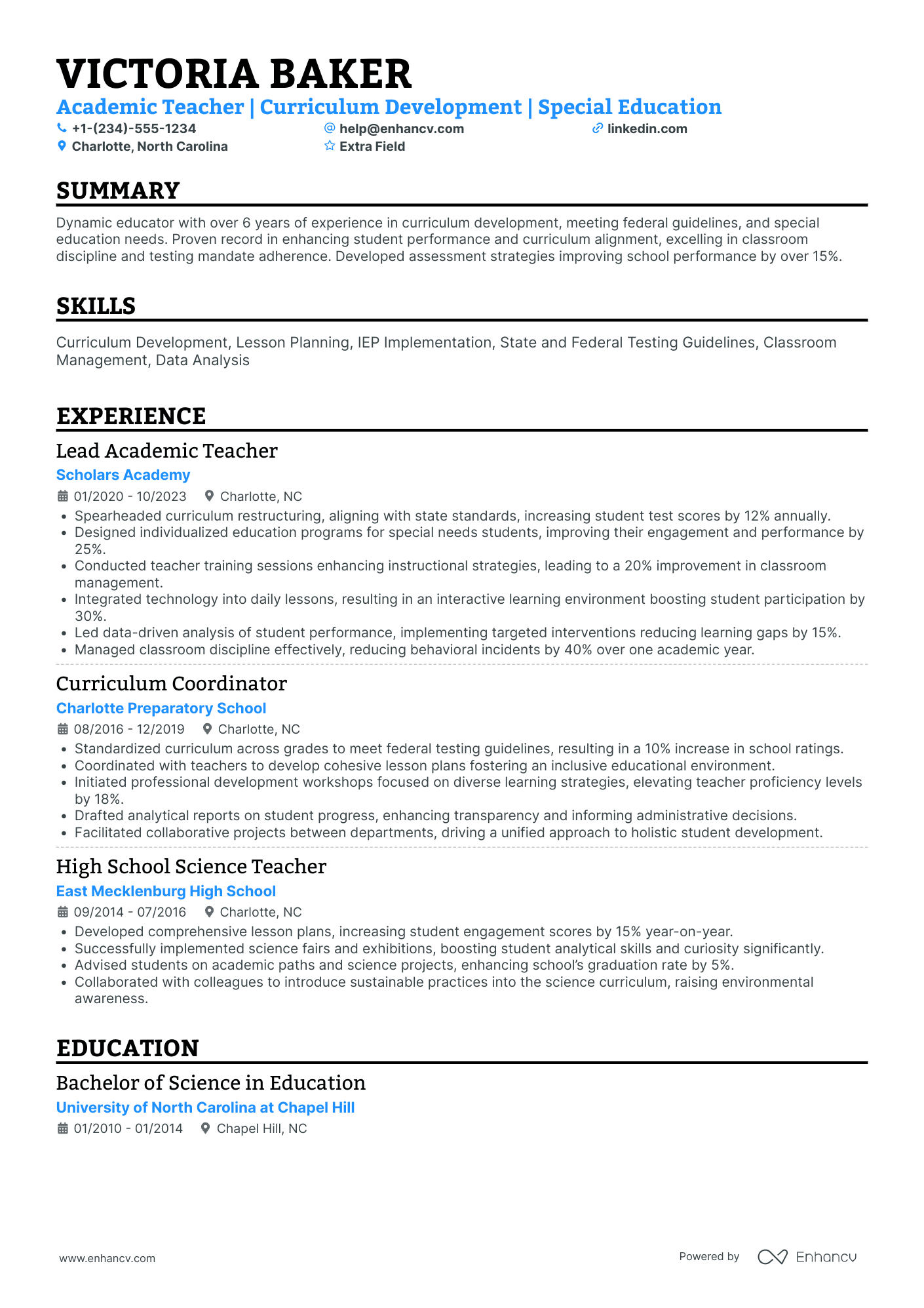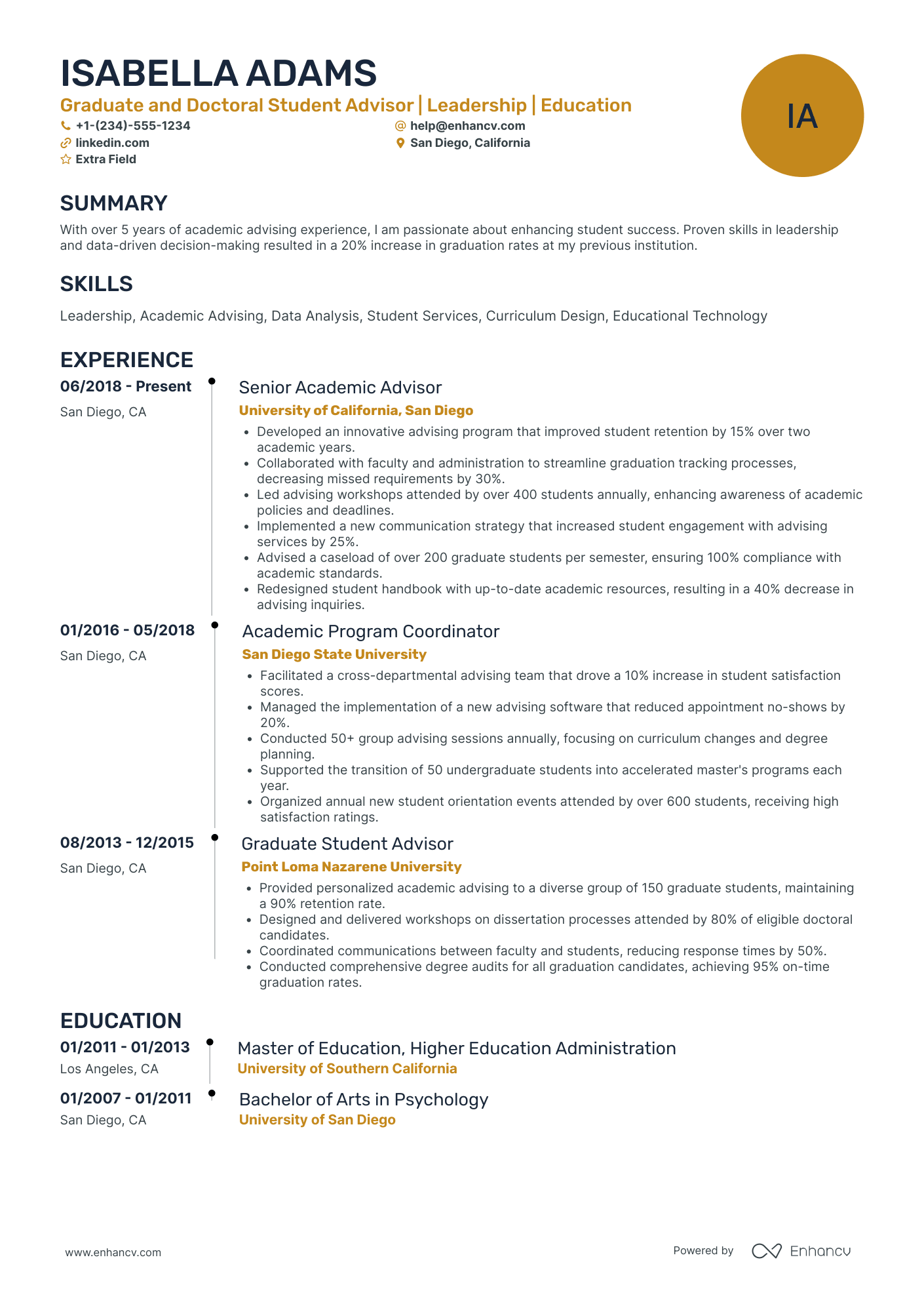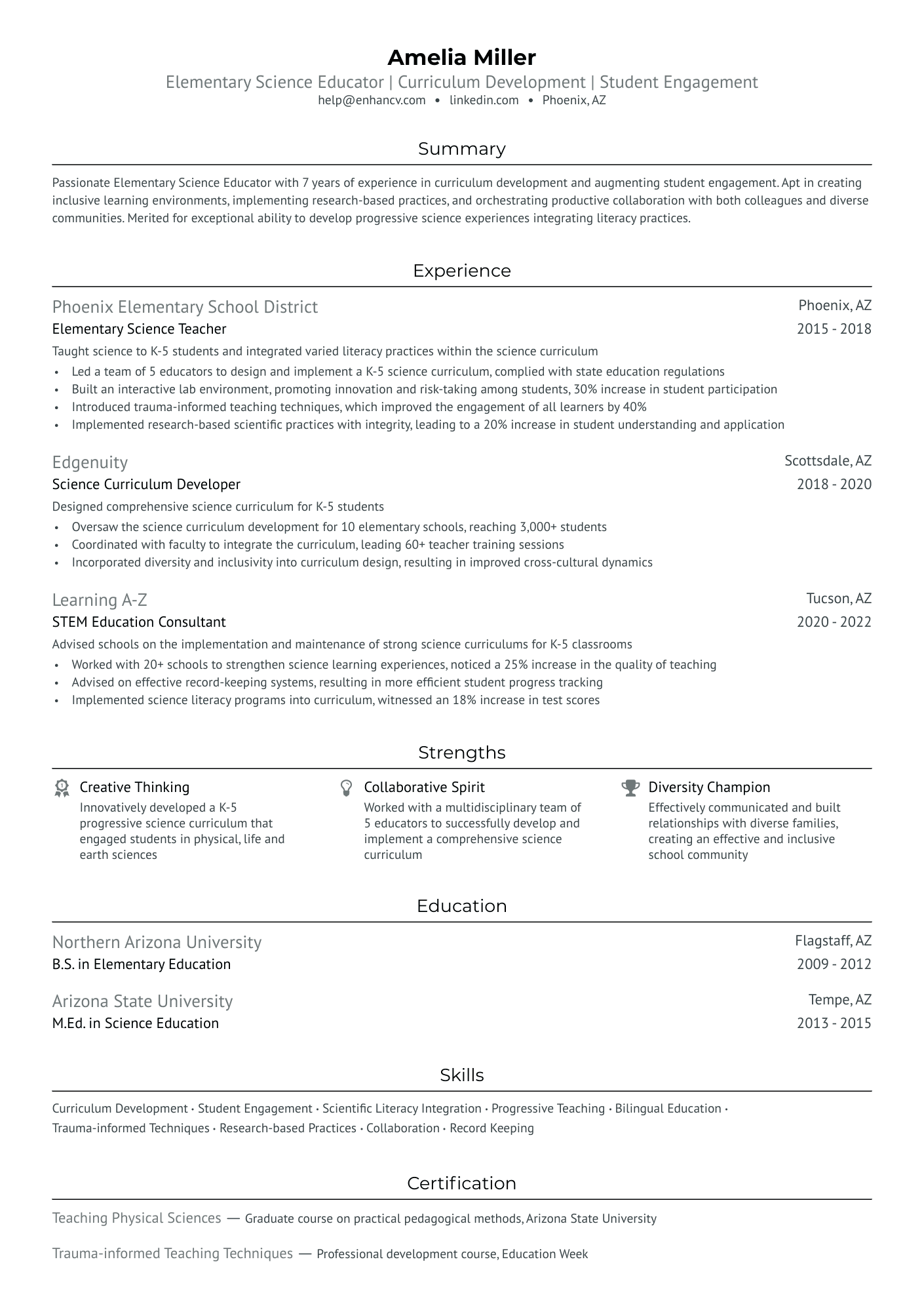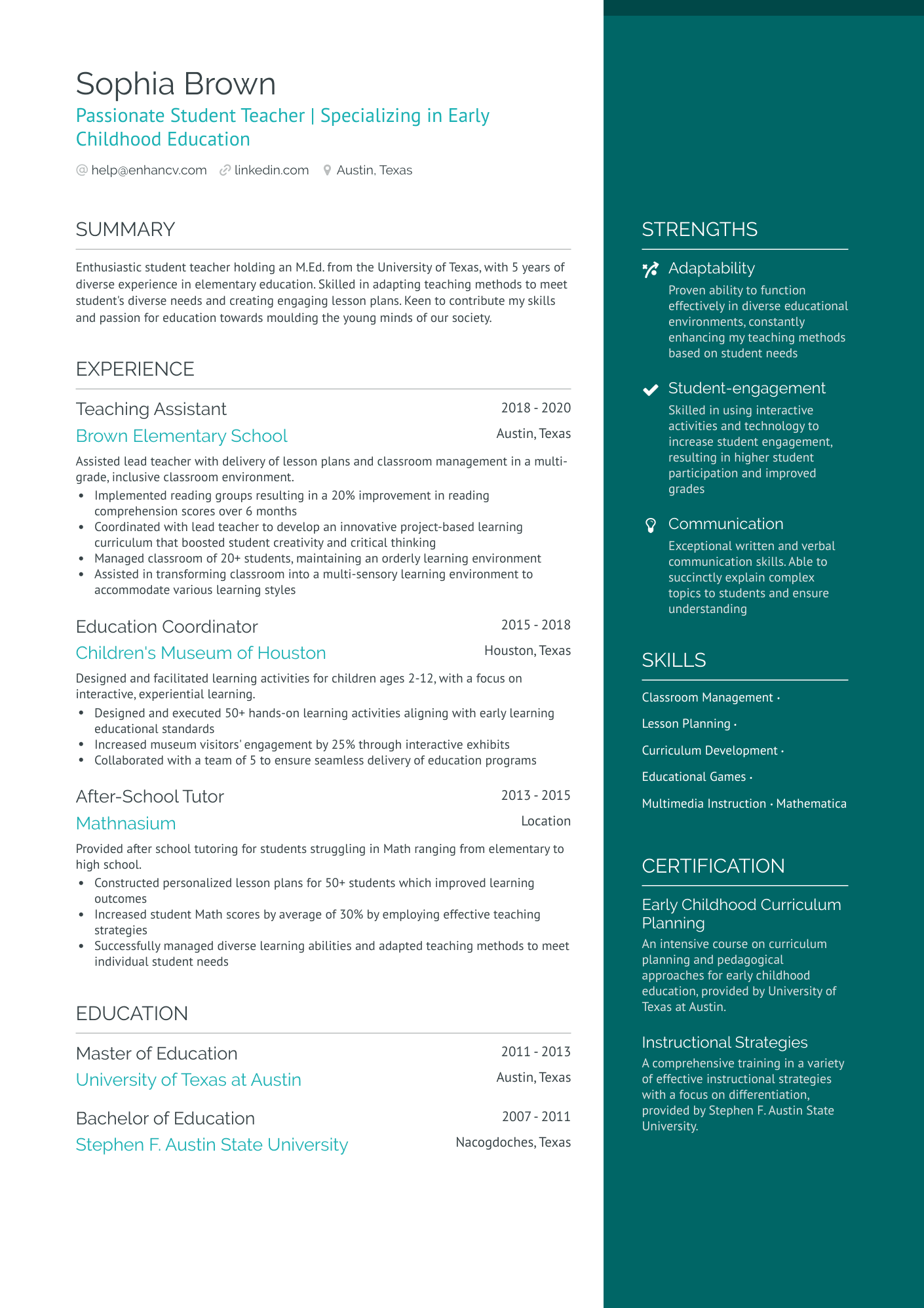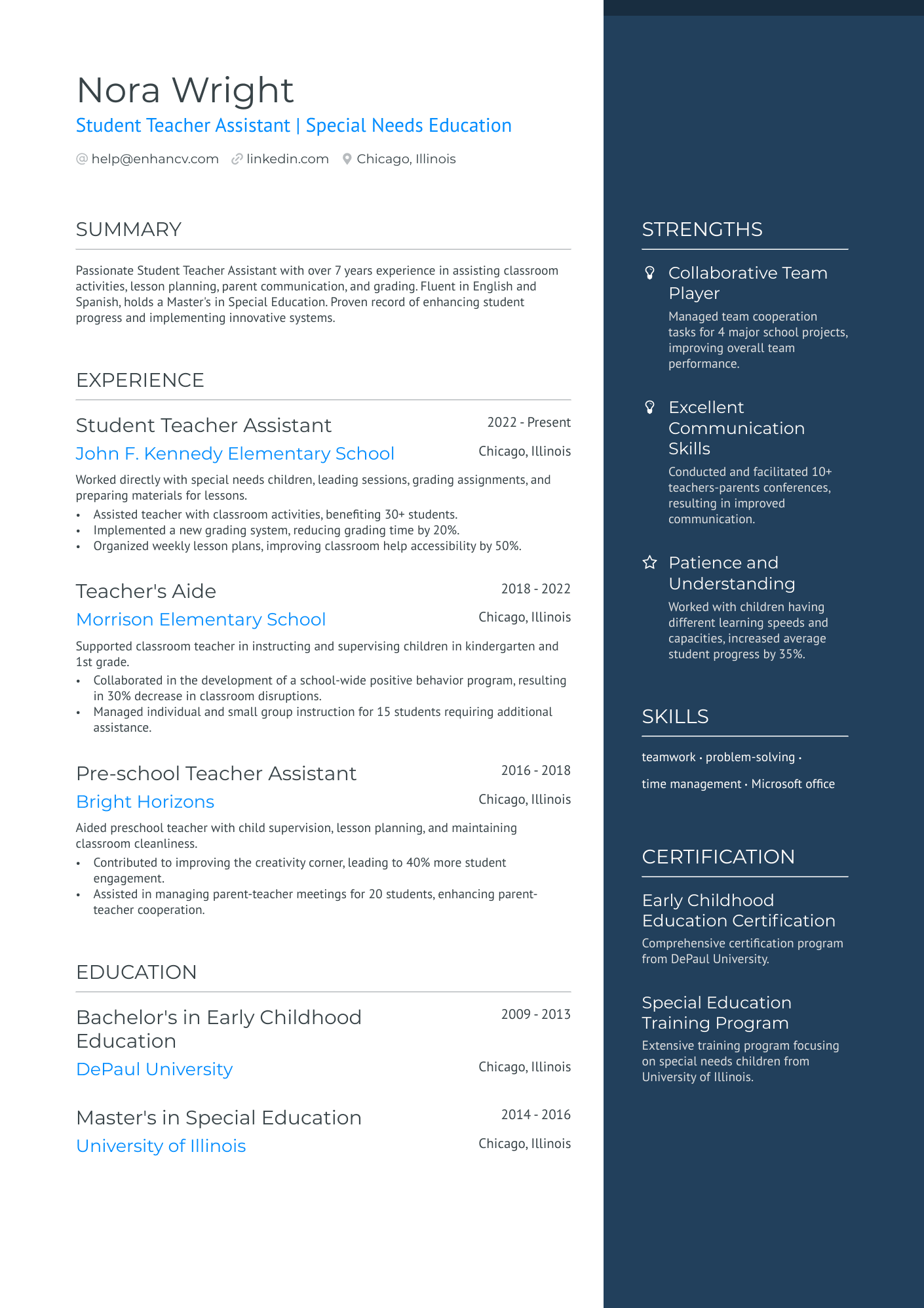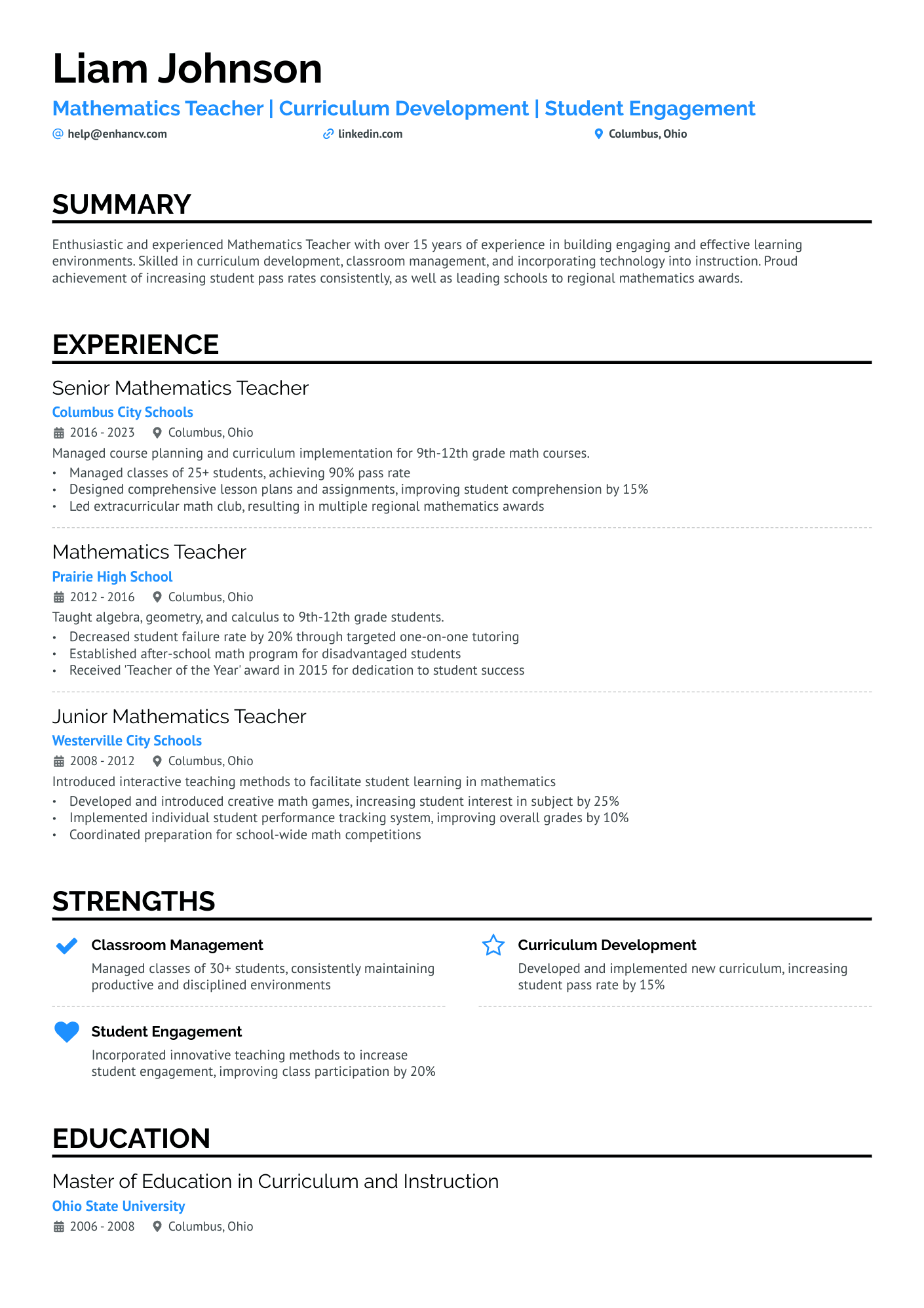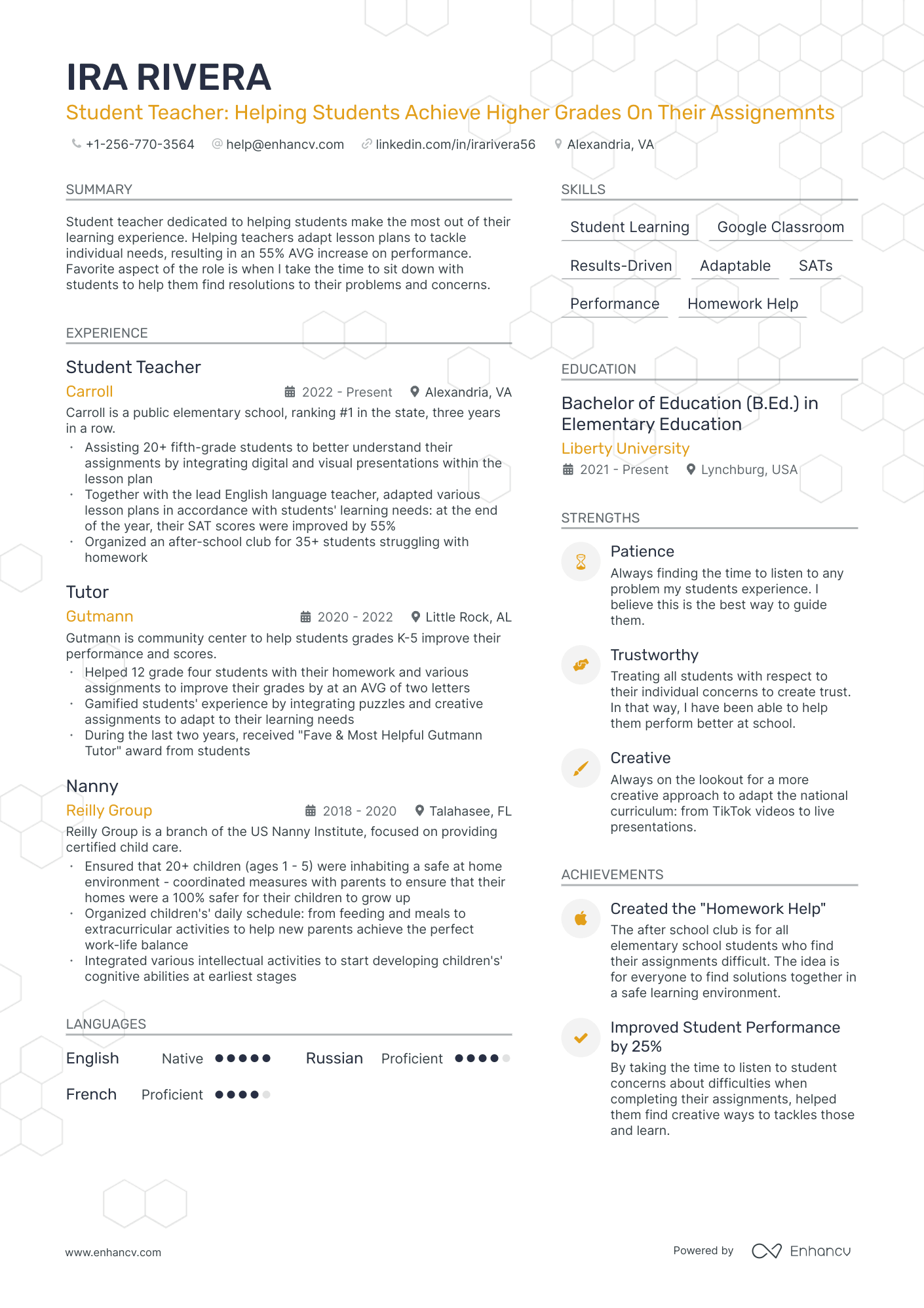Student teachers often struggle to effectively showcase their classroom experience and teaching skills in a resume.
Our student teacher resume guide provides targeted advice and examples to help you highlight your teaching competencies and practical classroom experiences in a compelling manner.
So, in this guide, we will:
- Show you real student teacher resume examples with explanations on why they work
- Teach you how to frame your professional qualifications so that they relate to the job description
- Help you build your experience section, even if you lack practical training
In case you’d like to check out related guides, browse through the ones below:
- Teacher resume general guide
- First grade teacher resume
- Substitute teacher resume
- First year teacher resume
- New teacher resume
Read on for more useful tips and advice!
Sample student teacher resume
As you know, the best way to learn is through examples. So, let’s review the student-teacher resume example above. Why does it work?
- Even though Ira hasn’t become a fully-fledged teacher yet, her experiences show that her focus has always been on working with children.
- The candidate has outlined not only her teaching approach but also what she expects as an outcome from her work as an educator.
- Ira shows she goes above and beyond for her students by organizing after-school activities.
- Plus, the applicant proves that her students’ well-being and care is as equally important as their education.
How to format your student teacher resume
Regardless of your teaching specialty, you know the importance of a clear and concise message when it comes to academic writing. The same goes for your resume:
- Distill your relevant teaching experience into no more than one page, if your work history is no more than three or four years.
- If you’re switching careers and have plenty of practical experience, your resume can span over two pages. But remember, be brief and to the point.
- Use the reverse-chronological resume format, starting with your most recent position first.
- Both single-column and double-column formats are ATS-friendly. So, feel free to add some variety to the design of your resume.
- Don’t forget to add your Professional Educator Licensure (PER) in the resume header. Include details about which grades and specific areas you’re eligible to teach.
- Pay special attention to the resume summary and the experience section. Highlight your teaching style and the various techniques you’re trained in.
- Before you save your resume, check if there are any special file type requirements listed in the job ad. If there aren’t, save it as a PDF to preserve the design.
Your resume should match the market – Canadian applications, for instance, may use a different layout.
Must-have sections on a student teacher's resume:
- A header that lists your contact details and professional licensure
- A resume objective or summary to provide an overview of your teaching style and goals
- An experience section that emphasizes the scope of your expertise
- An education and certificates box, listing your most relevant qualifications
- A skills segment which displays a good mix of your technical and social talents
What recruiters want to see on your resume:
- Are you able to put theory into practice? Show that you’re confident in your ability to engage and educate students.
- How quick are you in picking up your students’ needs? Not every student is the same, so display the various teaching methods you’re proficient in.
- How well do you adapt to your class? Indicate your ability to plan and pace your lessons according to your student’s needs.
- How do you measure your students’ performance? Demonstrate your understanding of what makes a successful student.
- Do your students know what’s expected of them once class begins? Emphasize your ability to plan and establish routines for turning in work and measuring performance.
- Prove that you have your student’s best interest. Confirm that you’re reliable and able to provide a safe space for students to voice their concerns.
- Being a student teacher doesn’t mean you’re permanently stuck in the classroom. Showcase your ability to collaborate with other staff members and teachers.
How to craft your student teacher resume experience
There are two key factors all successful resumes share:
- Data outlining the scope of the applicant’s expertise.
- Experience section full of accomplishments, not a laundry list of duties and responsibilities.
So, what can you put on your resume as a student teacher to ensure you’ve got everything covered?
The best way to do that is to:
- Mention the size of your classes or the total number of students you’ve taught so far.
- Refer to roles where you’ve had direct interactions with students, rather than doing administrative work.
- Concentrate on the results of your labor. Use the P-A-R (Problem-Action-Result) method to frame your achievements.
- List your experience in reverse chronological order. Detail only job-relevant experiences. Start with your most recently held position.
- Make sure all of your experience entries have your job title and period of employment listed.
- Include between 4 and 6 bullet points for each entry in the experience section.
- Start each bullet point with a resume action verb to make your application more powerful and impactful.
- Try to link your achievements and experience to what’s requested in the job description.
Pro tip
If you’re applying for a remote teaching position and your potential employer is located in another state, emphasize your familiarity with the state’s educational standards.
.l
How to quantify the impact on your resume
Principals are searching for candidates who will work towards the school’s goals and take its mission to heart.
As an aspiring teacher, you may not have lots of relevant experience. Still, you must prove you’re goal-oriented.
Show how your hard work has paid off so far by listing measurable achievements. For instance:
- Give examples of how you’ve dealt with students with varying educational needs.
- Have you tutored a student who went on to win an award? Boast about it!
- Have you developed IEPs for students with special needs? Share how your lesson planning skills have made an impact on your students’ lives.
- Flaunt any relevant awards and certifications you’ve acquired.
- Talk about how your support has helped lagging students stay on top of their studies.
- Mention how you stay up to date with current educational trends.
- Demonstrate how you’ve assisted other staff members complete their tasks.
We’ve prepared a few student-teacher experience section samples to illustrate how to do this. Compare the following entries:
- •Organized interactive group activities.
- •Helped struggling students.
- •Developed 30+ IEPs.
- •Achieved an overall of 40% increase in students' English literacy skills by organizing interactive group activities, aiming to relate core literature topics to current social issues.
- •Helped struggling students identify which aspects of learning is difficult for them through one-on-one tutoring sessions.
- •Developed 30+ IEPs for students with dyslexia and ADHD, which resulted in 90% of students being able to catch-up to their respective grade level in terms of knowledge and literacy.
The first example will get the candidate’s resume thrown straight into the trash because:
- Hanan hasn’t formatted the employment period correctly. As such, it’s not exactly certain whether the listed date is the beginning or end period of her tenure.
- There is no explanation as to how Hanan became a tutor with the Northside College Preparatory High School. Was she part of a special after-school program?
- Some of the bullet points merely refer to work-related tasks. And none of them provide enough context for when an accomplishment is cited.
Let’s look at another pair of samples:
- •Conducted parent-teacher meetings.
- •Organized math competitions.
- •Participated in the 2019 ICTM MATH Regional and State contests with a team of 7 students.
This time Hanan has used proper formatting for the date range of her employment. However:
- Her job title isn’t as informative as it can be. She has missed the opportunity to hint at her academic specialty where it can easily be noticed by principals.
- Hanan has failed to use the company description field to explain what led to her collaboration with Skinner Elementary School yet again.
- Not one bullet point refers to a measurable achievement. Remember, principals want to make sure your work will bring the desired results.
Look at the difference a few edits can make:
- •Conducted parent-teacher meetings to consult parents on the best extra-curricular programs and masterclasses available to their children.
- •Organized 14+ math competitions to expose students to a wide variety of logical puzzles and develop their abstract thinking.
- •Won two first places (for Algebra I and Geometry) at the 2019 ICTM MATH Regional and State contests by mentoring a team of 7 students.
Now Hanan can safely submit her resume and expect a callback!
Don’t worry if you don’t have experience as a tutor. Think about other roles you’ve held, where you’ve had to mentor other people.
Do you have experience as a camp counselor or a coach? Include it!
Take a look at the example below:
- •Organized Slam Poetry Nights to provide a space, where campers can discuss emotional and mental health issues.
- •Led and supervised field trips and hikes
- •Assisted and mentored students participating in the Happy Oak Performance Art Show.
This is how NOT to share your camp counselor experience.
Why?
Hanan hasn’t provided any information on what the results of her actions were.
In addition, she hasn’t mentioned where her job was located. Don’t forget, that principals must ensure you’re well-versed in the common core state standards for their state.
Finally, there’s no link to the camp’s website, nor a description which explains what the camp is about.
This makes it difficult for potential employers to ascertain whether this is a real job entry or not.
Here is a better version of this experience section entry:
- •Organized Slam Poetry Nights to provide a space, where campers can discuss emotional and mental health issues, which improved campers' confidence and ability to articulate their problems.
- •Led and supervised field trips and hikes, which aimed to teach students how to take inspiration for their art from nature.
- •Assisted and mentored students participating in the Happy Oak Performance Art Show, which resulted in 5 students finding a patron to fund their further studies.
How to showcase your hard skills and soft skills on your resume
Displaying a good mix of your technical and social talents on your resume is vital. That’s because your:
- Hard skills prove you have all the foundational knowledge to educate your students while working with the latest classroom equipment and software.
- Soft skills display your ability to be understanding of your students’ needs and take the appropriate actions to support them.
So, even though you’re on the cusp of becoming a student teacher, you must demonstrate you’re already a well-rounded professional.
Recall past roles, where your abilities have played a key role in achieving a goal. Then:
- Employ the P-A-R method to describe what happened, as well as the outcome of the situation.
- Begin your entry with a resume power verb.
- Include data and numbers to illustrate the impact of your accomplishment.
With all this in mind, here are some of the most popular student-teacher job skills to add to your resume:
Top hard skills for your student teacher resume
- CCSS
- Lesson planning and development
- Curriculum development
- 504 plans
- Grading and assessment skills
- Classroom management
- Standardized testing
- Mentoring
- Decision-making skills
- Presentation skills
- Multitasking
- Public speaking skills
- SMART board interactive displays
- Digital dissect
- Digital touch board
- Online classroom software
- Evaluation skills
- Administrative skills
- CPR
- Child care
Vital soft skills for your student teacher resume
- Collaboration
- Able to receive and understand feedback
- Building and nurturing relationships with students and parents
- Time management
- Organizational skills
- Resourcefulness and creativity
- Conflict resolution
- Problem-solving
- Communication skills
- Analytical and critical thinking skills
- Personable
- Trustworthiness
- Responsibility
- Accountability
- Ability to work under pressure
- Understanding and empathy
- Goal-oriented
- Attention to details
- Fast learner
- Adaptability
How to list your certifications and education on your resume
It goes without saying that your academic background and professional qualifications are an indispensable part of your resume.
That’s why when listing your education on your student teacher resume, be sure to:
- Add the name of your highest degree. Typically, most teaching positions require at least a bachelor’s degree in any education-related field.
- Include the name of your college and the month and year you graduated. If you’re still in college, list the expected graduation date.
- Is your GPA above 3.0? You made the dean’s list? Won a prestigious award? Share your academic successes to prove how well you thrive in a school setting.
- Think about which of your majors and minors would resonate with principals. Tailor your resume to the job description.
- If you’ve completed an internship while still in college, don’t forget to mention your experience.
Once you put everything down into writing, here is what your education section should look like:
- •Successfully completed an internship at STEM Magnet Academy, where I was responsible for 2 math classes and 1 engineering class.
- •Majored in Advanced Developmental Psychology and Educational Processes, Advanced Social Development of Children in an Urban Context and Characteristics and Assessment of Young Children with Disabilities.
But your degree alone won’t give you enough leverage to stand out among other student teachers. List any relevant certifications and licensures you have as follows:
Best certifications for your student teacher resume
- State Education Board Certifications
- National Early Childhood Program Accreditation (NECPA)
- Certified Preschool Professional (NECPA)
- Council for the Accreditation of Educator Preparation (CAEP) Certification
- CPR and First Aid
- Student Mental Health Certificate
- Gifted and Talented Education (GATE)
- Special Needs Caregiver Certificate
- Teaching English to Speakers of Other Languages (TESOL)
- American Sign Language teacher (ASL) certification
How to compose your student teacher resume summary or objective
Finally, to really get noticed by principals, write a compelling resume summary or objective.
How do you know which one is for you?
If you already have some practical experience or you’re switching careers, craft a powerful student teacher resume summary.
Start your summary by including your current position or the role you’re aiming for.
Next, state how many years of relevant experience you have and declare why you’re contacting the school.
Feature one or two job-related achievements and any transferable skills you have to offer.
The whole paragraph should be no longer than 100 words.
Have a look at the student teacher resume summary samples below:
The example starts off well. But by the time a principal finishes reading the first sentence, they would’ve lost interest in the candidate.
That’s because the wording isn’t as polished as it should be.
Plus, the applicant doesn’t describe how they acquired the listed skills. Despite citing being a camp counselor as a past position.
A better edit of the summary would be:
This is how you impress principals!
By contrast, if you’re a college grad trying to secure your first teaching role, craft a resume objective.
Explain what motivated you to become a teacher, as well as your general teaching approach. Share how your skills and expertise will benefit the school you’re applying to.
Be specific - discuss what age groups you’re specialized to teach.
Look at the example resume objective below:
It’s safe to say the candidate has relied on too many adjectives to support their application. Yet, there’s no reference to related achievements or skills.
Moreover, the phrasing is wrong. Remember, use first-person wording when writing your resume, but leave out the “I” pronoun.
A more refined version of the above resume objective would be:
Now the candidate has every chance of getting to the top of the resume pile!
Optimize your resume summary and objective for ATS
Drop your resume here or choose a file.
PDF & DOCX only. Max 2MB file size.
Additional sections for a student teacher resume
If you still have some space left on your resume, consider attaching extra sections. These help inform potential employers of other relevant skills and talents you may have.
For example, add any:
- Volunteering or community service experience you have
- Academic awards and prizes you’ve won
- Education-related books and papers you’ve written
- Hobbies and interests beneficial to school activities, such as photography and painting
- Language skills
Key takeaways
Let’s recap, to write an amazing resume for student teachers:
- Choose the reverse-chronological resume format to outline your experiences.
- Don’t forget to add your Professional Educator Licensure (PER) in the resume header.
- Describe what inspired you to become a teacher and list one prominent accomplishment in the resume summary.
- Make sure you quantify your experience by referencing relevant achievements.
- Create a balanced skills section by including both hard and soft skills.
- Outline your academic background and other related certifications in the education section.
- Enhance your resume by adding extra sections that display your personality.
Student Teacher resume examples
By Experience
By Role
